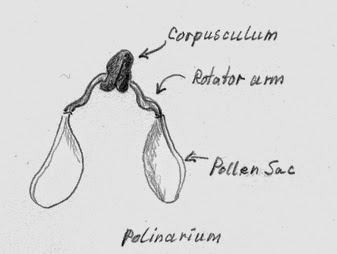To my delight, one seedling quickly appeared.
Pretty cute, eh?
You can even see the 'furriness' typical of young Milkweed plants, at least on the stem under the second pair of leaves.
But several weeks have now gone by and no more babies have popped up. Wondering what was happening, I did what I should have done in the first place, and checked a couple of books. In one, William Cullina's most excellent Growing and Propagating Wildflowers of the United States and Canada (I think there has been some propagating going on inside that title), I read that "seed germinates without a cold period, but it is slow and sporadic". Oops. Now I can't put the flat outside because of the one seedling so I'll just have to be patient. Oh well, I'm slow and sporadic myself.
Then I did some more reading, particularly in Milkweed, Monarchs and More by B. Rea, K. Oberhauser and M. A. Quinn. This is nifty little field guide to life in the Milkweed patch and is available from the MonarchWatch website. I learned about the Milkweed's unusual flower structure and its curious pollination mechanism.
These little sketches are adapted from the pictures in the book. In the upper one you see the typical Asclepias flower - just one, not the whole umbel - with the petals reflexed right back to the flower stem (and the sepals hidden underneath) to expose the business part of the flower to whatever bee, butterfly or beetle may be passing by. The 'hoods', which look like petals to us, hold nectar to entice the passing bee, butterfly et al. Between each pair of hoods is a slit in the central column. Each slit contains a little body (shown in the lower sketch) called a 'pollinarium'.
Each pollinarium has a sticky pad, a 'corpusculum', which attaches the pollinaria to the column, and from which two 'rotator arms' extend. The pollen is collected in sacs at the ends of the arms. When an insect touches a corpusculum, it sticks to its body, and when the insect leaves, it pulls the pollinarium out of the small slit. The arms are called 'rotator arms' because they rotate when the arms dry in the open air, so as to get the pollinarium into position to get stuck into the next slit the insect visits. Typically, pollinaria get stuck on insects' antennae, and do not easily release until the insect has had time to move to a new flower.
One pollen sac contains enough pollen to fertilize an entire umbel. The pollen grains grow down the column hidden inside the slit, fertilize the ovules, and the distinctive Milkweed pod forms.
Turns out there are about 110 species of Milkweed in North America. There are only 3 in the Ottawa area, the Common Milkweed, Butterfly Weed (A. tuberosa) and Swamp Milkweed (A. incarnata) although there is some thought that a fourth, A. exaltata, may occur not very far south of here. As well, there is a species, A. sullivantii, which is extremely similar to A. syriaca, hybridizes with it, and also may occur in the southernmost parts of the Valley. It differs mainly and most obviously in being smooth, while A. syriaca is usually quite downy.
Common Milkweed is an 'early succession' plant, that is, it is one of the first species to move in and colonize open or disturbed ground. Sometimes it eventually gets crowded out by other species.
Until this year, Milkweed was on the Ontario Noxious Weeds list, which meant that you weren't supposed to encourage it.... luckily for us, and hopefully the Monarchs, this is being changed.




Hi Lis, I just wanted to let everyone know about your other blog too, The Studio On The Ridge at http://studio-on-the-ridge.blogspot.ca/ Both blogs make excellent reading. I do wish more readers would comment, maybe even start a discussion.
ReplyDeleteHey, thanks! Nice to be appreciated!
ReplyDelete